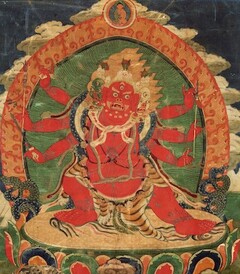Daily Hayagrīva Practice
༄༅། །རྟ་མགྲིན་རྒྱུན་ཁྱེར་བཞུགས་སོ། །
Daily Practice of Hayagrīva
by Jamyang Khyentse Chökyi Lodrö
སྐྱབས་སེམས་བཏང་ནས།
After taking refuge and generating bodhicitta:
ཧྲཱིཿལས་པདྨ་ཉི་མ་དང་། །
hrih lé pema nyima dang
Out of Hrīḥ, on a lotus and sun disc,
སྦྲུལ་བརྒྱད་བསྣོལ་བའི་གདན་སྟེང་ན།
drul gyé nolwé den teng na
And a seat of eight folded serpents,
སྐད་ཅིག་དྲན་རྫོགས་རྟ་མགྲིན་ནི། །
kechik dren dzok tamdrin ni
I appear as Hayagrīva, perfect in an instant of recollection.
དམར་པོ་ཞལ་གསུམ་ཕྱག་དྲུག་པ། །
marpo zhal sum chak drukpa
He is red with three faces and six arms,
དབུས་དམར་གཡས་ལྗང་གཡོན་དཀར་བ། །
ü mar yé jang yön karwa
The central face red, the right green and left white,
དབུ་གཙུག་རྟ་མགོ་གསུམ་གྱིས་མཚན། །
u tsuk ta go sum gyi tsen
All three featuring horse’s heads at the crown.
རྡོ་རྗེ་ཁ་ཊྭཱྃ་རལ་གྲི་གཡས། །
dorjé khatam raldri yé
He holds vajra, khaṭvāṅga and sword in his right hands,
སྡིག་མཛུབ་མདུང་ཐུང་རྒྱུ་ཞགས་གཡོན། །
dik dzub dungtung gyu zhak yön
Makes a threatening mudrā and holds a spear and lasso with his left hands.
ཞབས་བརྒྱད་དོར་སྟབས་སྟག་ཤམ་དང་།
zhab gyé dortab taksham dang
His eight legs are in the heroic stance and he wears a tiger-skin skirt.
མི་མགོ་སྐམ་རློན་སྦྲུལ་གྱིས་བརྒྱན། །
migo kam lön drul gyi gyen
Dried and fresh skulls and a chain of serpents adorn him,
ཡེ་ཤེས་མེ་དཔུང་བཞུགས་པར་གསལ། །
yeshe mepung zhukpar sal
And he stands amidst a blazing mass of wisdom fire.
ཐུགས་ཀར་ཉི་སྟེང་ཧྲཱིཿདམར་གསལ། །
tukkar nyi teng hrih mar sal
At his heart, upon a sun disc, is a clear red Hrīḥ
སྔགས་ཀྱི་ཕྲེང་བས་བསྐོར་བ་ལས། །
ngak kyi trengwé korwa lé
Surrounded by the mantra garland,
འོད་འཕྲོས་གདོན་བགེགས་ཀུན་བཅོམ་ཞིང་། །
ö trö dön gek kün chom zhing
From which light radiates out to destroy all harmful influences and obstacles
བྱིན་རླབས་དངོས་གྲུབ་ཐོབ་པར་གྱུར།
jinlab ngödrub tobpar gyur
And to bring the attainment of blessings and accomplishment.
ཨོཾ་ཧྲཱིཿཔདྨཱནྟ་ཀྲྀཏ་བཛྲ་ཀྲོ་དྷ་ཧྱ་གྷྲཱི་ཝ་ཧུ་ལུ་ཧུ་ལུ་ཧཱུྃ་ཕཊཿ
om hrih pemanta krita benza krodha hyaghriwa huluhulu hung pé
oṃ hrīḥ padmānta kṛta vajra krodha hayagrīva hulu hulu hūṃ phaṭ
ཞེས་བཟླ། ཐུན་མཐར།
Recite this mantra. At the end of the session, continue with:
ལྷར་སྣང་ཆོས་ཉིད་དབྱིངས་སུ་ཐིམ། །
lhar nang chönyi ying su tim
Appearance as the deity dissolves into the space of dharmatā.
སླར་ཡང་རྟ་མགྲིན་སྐུ་རུ་ལྡང་། །
lar yang tamdrin ku ru dang
Then, once again, I arise in the form of Hayagrīva.
ཨོཾ་ཨཱཿཧཱུྃ།
om ah hung
oṃ āḥ hūṃ
གིས་གནས་གསུམ་སྲུངས།
Recite this to guard the three centres. Then conclude with:
དགེ་བ་འདི་ཡིས་མྱུར་དུ་བདག །
gewa di yi nyurdu dak
Through the positivity and merit of this, may I swiftly
དབང་ཆེན་རྟ་མགྲིན་འགྲུབ་གྱུར་ནས། །
wangchen tamdrin drub gyur né
Attain the realization of Hayagrīva, and thereby
འགྲོ་བ་གཅིག་ཀྱང་མ་ལུས་པ།
drowa chik kyang malüpa
Every single sentient being
དེ་ཡི་ས་ལ་འགོད་པར་ཤོག
dé yi sa la göpar shok
Reach his state of perfection too.
སོགས་བསྔོ་སྨོན་བྱའོ། །
With this, dedicate the merit and make prayers of aspiration.
ཞེས་པའང་བསོད་ནམས་རྒྱལ་མཚན་གྱི་ངོར་ཆོས་ཀྱི་བློ་གྲོས་པས་སོ།། །།
Chökyi Lodrö wrote this for Sonam Gyaltsen.
| Translated by Adam Pearcey with the generous support of the Khyentse Foundation and Tertön Sogyal Trust, 2020.
Source:
'Jam dbyangs chos kyi blo gros. "rta mgrin rgyun 'khyer/" in ’Jam dbyangs chos kyi blo gros kyi gsung ’bum. 12 vols. Bir: Khyentse Labrang, 2012. W1KG12986 Vol. 6: 310–311
